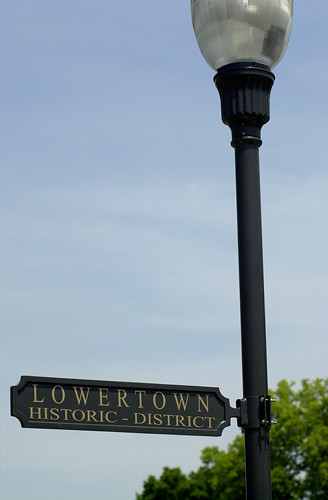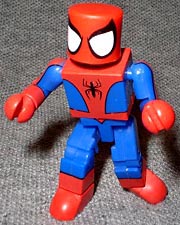The Associated Press came calling and when they do - You answer. (Cause they pay good) So my adventures took me to the Paducah, Ky., downtown area to shoot the Artist Relocation Program ... better known as Lower Town.
Below is Elizabeth Dunbar's story ...
Enjoy - Spydie**
Artist relocation program has revived small Kentucky town
By ELIZABETH DUNBAR
Associated Press Writer
PADUCAH, Ky. (AP) - Wandering in and out of galleries, visitors to the Lower Town neighborhood might feel like they're in an artsy part of Chicago or San Francisco _ not this Ohio River town of 26,000 in far western Kentucky.
The quiet streets are lined with century-old brick houses, more than a dozen of which have signs indicating the house contains an artist's gallery or studio. Even a life-sized stainless steel giraffe welcomes visitors to one gallery.
Inside, Paulette Mentor experiments with colorful liquid acrylic paint, pressing two small square canvases together, then pulling them apart to reveal unique designs.
Mentor was flipping channels at home in Washington a few years ago when she came across a PBS feature on Paducah's artist relocation program. She visited the city a couple of times, decided to move from the Pacific Northwest and has since refurbished an old house that became her new home, studio and gallery. Besides her own work, the gallery features dramatic contemporary paintings and prints, sculptures and glass created by other artists here and elsewhere.
At least a two hour drive from any major city _ Nashville is 135 miles to the southeast _ Paducah started with just a couple of artists six years ago. The relocation program now has more than 70 artists who have helped put Paducah on the map as a U.S. art destination.
City officials credit the program with boosting economic growth and helping revitalize a formerly rundown neighborhood. And artists say the program has helped them grow professionally and become a part of a close-knit community.
"People here are extremely friendly and supportive," said Mentor, who moved to Paducah shortly after her husband died. "It's been very positive."
Tom Barnett, the city's planning director who worked with a local artist to launch the program, loves to hear it. The artist, Mark Barone, was living in the Lower Town neighborhood in the late 1990s and complained to the city about neglected properties and the transient population _ including drug dealers _ renting living space.
"It's a story you see throughout this country," Barnett said of Lower Town, which had been in decline since the 1950s as people struggled to care for older houses. "The people of Paducah had written the area off."
Prompted by Barone, however, city officials began enforcing things like inspections and licenses for the area's rental properties. Then, Barone saw an advertisement for an artist community in Rising Sun, Ind., and he and Barnett started working together to see if Paducah could have something similar.
Paducah Bank agreed to support the program by lending 100 percent of the costs for construction or acquisition and rehabilitation at an interest rate that would be locked up for 30 years. In many cases, the loans amounted to 200-300 percent of the property's appraised value after it had been fixed up.
"The bank really took a risk and got on board," Barnett said. "They were in a position that if someone went belly up, they would have lost money."
The city also took a risk in the beginning by practically giving away some of the property to artists without requiring them to stay for a certain amount of time.
"We tried to not put too many restrictions," Barnett said. Still, the city received most of the money back within a couple of years through property taxes and fees for permits and business licenses. For every $1 the city has put into the program, it's received $14 back, Barnett said.
The Lower Town neighborhood has since been transformed, and prominent observers have even called it "the SoHo of the South."
"No one expected this response," said Bill Renzulli, a retired physician who was one of the first artists to join the program. He restored a house that would have otherwise been demolished; he has since opened a gallery featuring his paintings of landscapes and famous buildings.
Artists aren't the only people moving into Lower Town. Monica Bilak opened the Global Nomad, a coffee and gift shop, after moving to Paducah two years ago. She has lived in Los Angeles, Nashville, Tenn., and even Kenya, but said that she and her family will stay here for a while.
"It's kind of breaking out of the small, Southern town stereotype. It's a funky town," Bilak said.
The galleries themselves feature a diverse mix of art, including jewelry, ceramics, paintings and quilts. Like Mentor's, some feature multiple artists' works; others feature one or two artists.
Marta Utsler and her husband, Joel, have a gallery in their home to display their own paintings. In a room at the back of the house, Utsler works with a large canvas, layering different colors of paint and later scratching it off in places for what she calls a "nonrepresentational" result. The Utslers renovated their home, which now has hardwood floors and a lot of natural light.
The makeover of Lower Town isn't surprising to Roy Close, resource development director for ArtSpace. The Minneapolis-based nonprofit develops affordable space for artists and has worked on various projects throughout the country. Close said artist communities are great for cities.
"When you bring in artists, they colonize a neighborhood. They're good citizens," he said. "They are very likely to become community activists."
New York's SoHo neighborhood is the classic example, but thriving art communities have popped up and helped revive smaller cities as well: Santa Fe, N.M.; Ashland, Ore.; Reno, Nev.; and Asheville, N.C., to name a few. A working-class and industrial neighborhood in northeast Minneapolis is being transformed into a place where artists live and work. And the Pioneer Square Historic District in Seattle is home to dozens of galleries housed in restored old buildings.
The problem arises when property values increase and the neighborhood becomes too expensive for the artists to remain, Close said. It happened in New York and in the downtown Minneapolis Warehouse District. That outcome prompted Artspace to evolve into not just an advocate for artists being forced out of desirable neighborhoods, but a developer that refurbishes and constructs places so artists can stay in the area.
Barnett said rising property values in Lower Town have already become a concern.
"In some ways, we're a victim of our own success," he said.
Some of the deals the city is able to offer artists aren't quite as good as they were six years ago, but Barnett said plenty of relocation opportunities still exist, and artists keep coming to take them.
The Paducah artists say they've been successful selling art both to local residents and to people who visit from out of town. Thousands of tourists, many arriving on riverboats, come to Paducah each year to attend town festivals and shop for antiques.
"Everyone is hearing about us," Utsler said.
She's also enjoying Paducah's other amenities in nearby downtown, such as upscale restaurants, a movie theater that shows independent films and a $44 million performing arts center fit for Broadway shows, which opened two years ago.
"There's always somewhere to go and something to see," Utsler said.
And some of the artists say their peers have offered inspiration and encouragement that has made their art progress.
"I can't stop painting. I keep running out of canvases," Mentor said.
Saturday, August 12, 2006
Lower Town Art District
Subscribe to:
Post Comments (Atom)



No comments:
Post a Comment